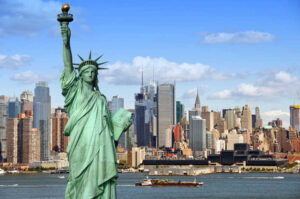New York City air quality reaches dangerous levels due to Canadian wildfire smoke

Smoke from hundreds of wildfires burning in Canada continues to create dangerous air quality conditions across New York City and the Tri-State.
Health officials are urging area residents to limit outdoor activities on Wednesday.
The National Weather Service has issued an Air Quality Alert for New York City and parts of the Tri-State area.
At this point, New York City schools remain open, but students will not be doing any outdoor activities during their school day.
Smoke from Canada’s wildfires has been moving into the United States since last month. The most recent fires near Quebec have been burning for at least several days.
The U.S. Environmental Protection Agency said hazy skies, reduced visibility and the odor of burning wood are likely, and that the smoke will linger for a few days in northern states.
“It’s not unusual for us to get fire smoke in our area. It’s very typical in terms of northwest Canada,” said Darren Austin, a meteorologist and senior air quality specialist with the Rhode Island Department of Environmental Management. But, usually, the smoke has been aloft and hasn’t affected people’s health, he said.
The Quebec-area fires are big and relatively close, about 500 to 600 miles (roughly 800 to 970 kilometers) away from Rhode Island. And they followed wildfires in Nova Scotia, which resulted in a short-lived air quality alert on May 30, Austin said.
Jay Engle, a National Weather Service meteorologist based in Upton, Long Island, said the wind trajectory that allowed smoke and hazy conditions to be seen in the New York City area could continue for the next few days. Of course, he said, the main driver of conditions is the fires themselves. If they diminish, the haze would too.
The smoke is making for potentially dangerous conditions, especially for people with respiratory issues.
Exposure to elevated fine particle pollution levels can affect the lungs and heart.
The air quality alerts caution “sensitive groups,” a big category that includes children, older adults, and people with lung diseases, such as asthma and chronic obstructive pulmonary disease.
Dr. Jack Caravanos is an environmental health expert at NYU who studies environmental toxins and pollution. He says because of the Canadian wildfires, the air quality is three times worse than normal.
“As time goes on, the air inside a building will ultimately equal the air outside, so for homes, restaurants, delicatessens, the air quality inside will pretty much match the air quality outside, especially as this thing goes on for a few days,” Caravanos said.
Kids, who often are encouraged to go out and play, “are more susceptible to smoke for a number of reasons,” said Laura Kate Bender, the lung association’s National Assistant Vice President, healthy air. “Their lungs are still developing, they breathe in more air per unit of body weight.”
The New York City Department of Education recommended that “prolonged outdoor activity be limited and that special attention be made to vulnerable students and staff populations.”
Meanwhile, Northern Quebec’s largest town was being evacuated as authorities turned their attention to communities in the northern and northwestern parts of the province where firefighters worked to beat back threats from out-of-control blazes.
According to the province’s forest fire prevention agency, more than 150 forest fires were burning in the province on Tuesday, including more than 110 deemed out of control.
Quebec Natural Resources Minister Maté Blanchette Vézina told reporters in Quebec City that evacuees across the province number just over 8,300, down from 10,000 to start the week, but the Abitibi region remains a concern.
“We are not expecting rain in the short term, which is what makes it more difficult to fight fires,” Blanchette Vézina said.

